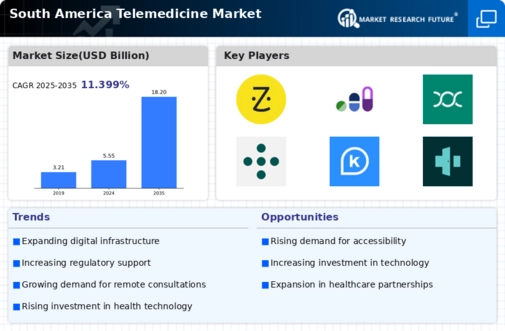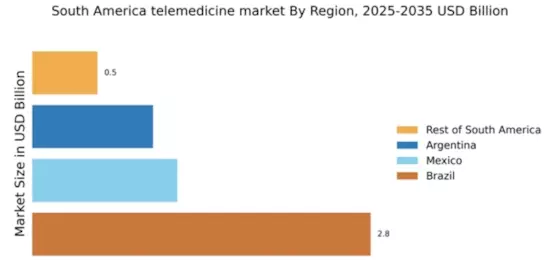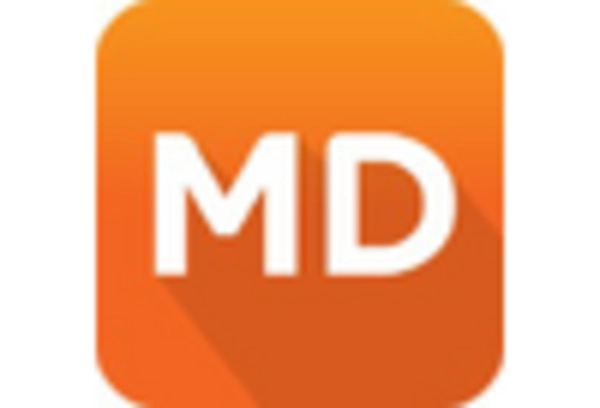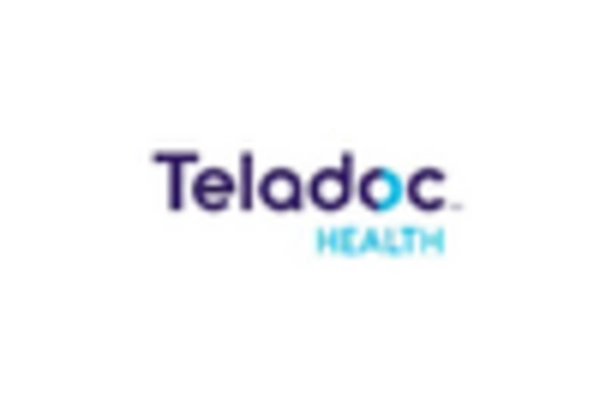Growing Focus on Mental Health Services
The growing focus on mental health services is emerging as a crucial driver for the telemedicine market in South America. Mental health issues have gained increased recognition, with studies indicating that nearly 25% of the population experiences some form of mental health disorder. Telemedicine provides a discreet and accessible platform for individuals seeking mental health support, particularly in regions where stigma may deter in-person visits. The convenience of virtual therapy sessions allows patients to receive timely care, which is essential for effective treatment. As mental health awareness continues to rise, the demand for telehealth services in this sector is expected to grow significantly. This trend may lead to an expansion of telemedicine offerings, with a projected increase in mental health service utilization by approximately 40% over the next few years.
Increased Health Literacy and Awareness
Increased health literacy and awareness among the South American population is a vital driver of the telemedicine market. As individuals become more informed about their health and available healthcare options, they are more likely to seek out telehealth services. Educational initiatives and public health campaigns have contributed to a greater understanding of the benefits of telemedicine, including convenience and accessibility. Recent surveys indicate that around 70% of the population is aware of telehealth services and their advantages. This heightened awareness is likely to translate into increased utilization of telemedicine platforms, as patients actively seek out remote consultations for various health concerns. Consequently, the telemedicine market is expected to experience a robust growth trajectory, with an anticipated rise in user engagement of approximately 25% in the coming years.
Cost-Effectiveness of Telehealth Solutions
The cost-effectiveness of telehealth solutions significantly influences the telemedicine market in South America. With rising healthcare costs, both patients and providers are seeking more affordable alternatives. Telemedicine reduces overhead expenses associated with traditional healthcare delivery, such as facility maintenance and staffing. A recent analysis indicates that telemedicine consultations can be up to 30% cheaper than in-person visits, making it an attractive option for budget-conscious patients. Furthermore, insurance companies are increasingly recognizing the value of telehealth, leading to expanded coverage options. This shift not only enhances accessibility for patients but also encourages healthcare providers to adopt telemedicine practices. As a result, the market is likely to witness a steady increase in adoption, driven by the financial benefits associated with telehealth services.
Technological Advancements in Communication
Technological advancements play a pivotal role in shaping the telemedicine market in South America. The proliferation of high-speed internet and mobile connectivity has facilitated seamless communication between patients and healthcare providers. As of November 2025, over 80% of urban areas in South America have access to reliable internet services, enabling the effective delivery of telehealth services. Additionally, the integration of artificial intelligence and machine learning into telemedicine platforms enhances diagnostic accuracy and patient engagement. These innovations not only improve the quality of care but also attract a broader demographic to telemedicine services. Consequently, the market is poised for substantial growth, with an estimated increase in user adoption rates of approximately 20% over the next few years.
Rising Demand for Remote Healthcare Services
The telemedicine market in South America experiences a notable surge in demand for remote healthcare services. This trend is driven by the increasing prevalence of chronic diseases, which necessitate ongoing medical attention. According to recent data, approximately 60% of the population in South America suffers from at least one chronic condition, leading to a heightened need for accessible healthcare solutions. Telemedicine offers a viable alternative, allowing patients to consult healthcare professionals without the constraints of geographical barriers. Furthermore, the convenience of remote consultations appeals to a population that values time efficiency. As a result, the telemedicine market is likely to expand, with projections indicating a growth rate of around 15% annually over the next five years.


















Leave a Comment